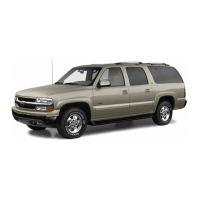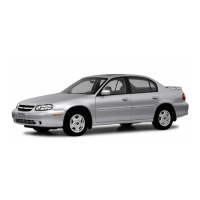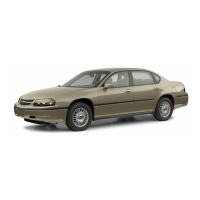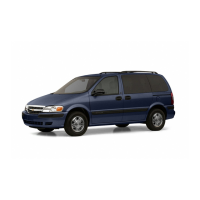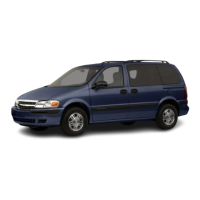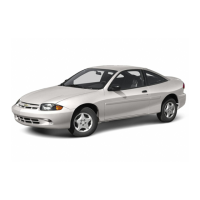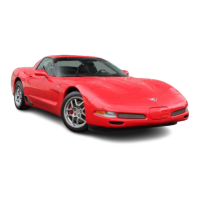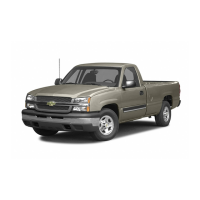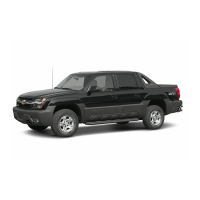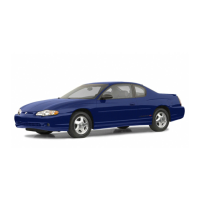Do you have a question about the Chevrolet 2003 Blazer and is the answer not in the manual?
Covers manual and power seat adjustments, lumbar support, and heated seats.
Details operation of folding rear seatbacks and head restraints.
Explains proper usage, answers questions, and covers use during pregnancy.
Discusses proper use for older children, infants, and young children.
Explains how airbags work, their location, and safety precautions.
Guides on checking and replacing restraint system parts after a crash.
Describes the vehicle's key system and the importance of having spare keys.
Explains the operation and conditions for the remote keyless entry transmitter.
Covers manual locking, power locks, programmable options, and security locks.
Safety caution about leaving children in vehicles with windows closed.
Instructions for operating and closing rear swing-out windows.
Safety caution about driving with the rear window or endgate open.
Explains how to operate manual and power tailgate releases.
Details the use of the REAR HATCH button for releasing rear glass.
Provides instructions for emergency tailgate opening using a release lever.
Explains how to move the carrier arm for tailgate-mounted spare tires.
Describes how to adjust sun visors for glare reduction.
Covers Content Theft-Deterrent and Passlock® systems.
Guides on vehicle startup, ignition positions, and break-in procedures.
Manual, automatic dimming, convex, and heated outside mirrors.
Operation and programming of the HomeLink universal transmitter.
Details glove box, overhead console, and front storage area features.
Explains the display of outside temperature and compass direction.
Explains the DIC system for displaying vehicle information.
Covers memory seat functions for saving driver preferences.
Describes the function of assist handles above passenger doors.
Mentions garment hooks on headliners.
Describes the vehicle's luggage carrier, including cautions for carrying items.
Explains the use of a convenience net in the rear for securing small items.
Identifies the location of rear cargo tie-downs.
Instructions for using and storing the cargo cover.
Details the rear convenience system for storing loose items.
Identifies the main components of the instrument panel.
Explains the function of hazard warning flashers for signaling problems.
Mentions the use of reflective triangles as a warning device.
How to sound the horn.
Instructions for adjusting the steering wheel using the tilt lever.
Details the functions of the lever, including turn signals and wipers.
Explains how to use turn and lane-change signals, and what to do if a bulb is out.
How to switch between high and low beams using the multifunction lever.
How to use high-beam headlamps to signal a driver for passing.
Operation of windshield wipers, including mist and off settings.
Operation of the windshield washer and fluid level check.
Control for the rear window wiper and washer.
Explains how to maintain speed without using the accelerator pedal.
Step-by-step instructions for setting cruise control.
Controls for operating exterior lamps, including automatic headlamp mode.
Operation of the automatic headlamp system based on light sensor input.
Explains the reminder chime for headlamps/parking lamps.
Details the function and conditions for Daytime Running Lamps (DRL).
How to use fog lamps for better visibility in foggy conditions.
Covers instrumental panel brightness, entry lighting, reading lamps, and dome lamps.
How to control heating, cooling, and ventilation for the vehicle.
Explains the purpose of warning lights and gauges for vehicle functions.
Overview of the base level instrument panel cluster layout.
Overview of the up-level instrument panel cluster layout.
Explains how to read speed and mileage, and what happens with new odometers.
How to view and reset the trip odometer.
Explains the tachometer's function and warns against operating in shaded areas.
Describes the safety belt reminder light and chime.
Explains the air bag readiness light and when to seek service.
Details the charging system light and potential issues.
Explains the voltmeter gauge for checking battery state and charging system.
Explains the up-shift light for manual transmissions to improve fuel economy.
Explains the brake system warning light and its implications.
Describes the ABS warning light and its function.
Explains the engine coolant temperature gauge and what the red area indicates.
Details the "Service Engine Soon" or "Check Engine" light and its causes.
Actions to take if the malfunction indicator light is flashing.
Troubleshooting steps if the malfunction indicator light stays on.
Information on how emissions inspections relate to warning lights.
Explains the oil pressure gauge and low oil pressure warnings.
Function of the security light related to the Passlock system.
Explains the SERVICE 4WD warning light for system issues.
Indicates when the tow/haul mode has been selected.
When the check gages light comes on while driving.
Indicates if the endgate or liftglass is ajar.
How the fuel gauge indicates remaining fuel.
Indicates when the fuel tank is low on fuel.
Covers radio operation, settings, and system features.
How to find radio stations using TUNE, SEEK, and SCAN functions.
How to set and recall favorite radio stations using numbered pushbuttons.
How to adjust bass, treble, and overall tone settings.
Detailed steps for adjusting speaker balance and fade.
Features of the Radio Data System (RDS) for receiving information.
How to find stations based on Program Type (PTY).
Instructions for playing CDs, including track navigation and random play.
How to select and play a specific CD from a loaded stack.
Details about the six-disc CD player.
How to play the radio with the six-disc CD system.
Automatic volume adjustment based on vehicle speed and noise.
How to find radio stations using TUNE, SEEK, and SCAN.
How to set and recall favorite radio stations using pushbuttons.
How to adjust bass, treble, and overall tone settings.
Explains the importance of driver behavior, environment, and vehicle design.
Emphasizes buckling up, avoiding speed, turns, and drunk driving.
Tips for driving in inclement weather, at night, and in unfamiliar areas.
Discusses utility vehicle design, center of gravity, and handling characteristics.
Advice on being prepared for unexpected situations and anticipating others' actions.
Information on the dangers of alcohol and driving, including BAC effects.
Explains the role of brakes, steering, and accelerator systems in vehicle control.
Details perception and reaction time, stopping distances, and brake care.
Explains the ABS system and its function in preventing skids.
How to steer and brake simultaneously in emergency situations.
Advice on driving on curves, maintaining speed, and avoiding acceleration.
Using steering effectively to avoid collisions when braking is insufficient.
How to recover a vehicle that has gone off the road onto the shoulder.
Tips for safely passing other vehicles on two-lane highways.
What happens when control systems lack friction, and how to react in emergencies.
Explains types of skids and how to handle them, focusing on defensive driving.
Guide to off-road driving, including hazards and necessary skills.
Rules for protecting the environment while off-roading.
Planning tips for trips to remote areas, including maps and travel companions.
Practicing off-road driving skills in safe, nearby areas.
How to assess terrain conditions and anticipate obstacles for off-road driving.
Advice on safely driving up, down, and across off-road hills.
Factors to consider when approaching hills, including steepness and obstacles.
Special steps for safely driving up hills, including gear selection and steering.
Procedure for handling a stalled vehicle on a hill, including safety steps.
Considerations for driving downhill, including surface conditions and obstacles.
How to drive in various slippery conditions and maintain traction.
Precautions and procedures for driving through deep puddles or standing water.
Warnings about the dangers of flowing water and how it can carry away vehicles.
Additional tips for driving safely in rainy weather.
Strategies for safe and efficient city driving, focusing on traffic and signals.
Advice on freeway driving, including merging, lane changes, and speed.
Checklist for preparing the vehicle and driver for a long trip.
Awareness and prevention of highway hypnosis or falling asleep at the wheel.
Driving tips specific to steep hills and mountain roads.
Tips and emergency supplies for driving in winter conditions.
How to drive in various slippery conditions and maintain traction.
Actions to take if caught in a blizzard, including summoning help and staying warm.
Methods for freeing a stuck vehicle, including "rocking" and using recovery hooks.
Step-by-step instructions on how to "rock" a stuck vehicle free.
How and when to use vehicle recovery hooks.
General information and considerations for towing vehicles.
Consulting dealers and professionals for towing disabled vehicles.
Types of recreational towing (dinghy, dolly) and important considerations.
Instructions and cautions for dinghy towing, specifically for two-wheel drive vehicles.
Instructions and cautions for dolly towing, specifically for two-wheel drive vehicles.
How to load the vehicle correctly, considering weight distribution and capacity.
Understanding payload capacity and how added accessories affect it.
Comprehensive advice on towing trailers safely, including laws and equipment.
Maintaining adequate following distance when towing a trailer.
Advice on passing other vehicles while towing a trailer, requiring more distance.
Techniques for backing up with a trailer, emphasizing slow and guided maneuvers.
How to make wider turns to avoid trailer contact with the vehicle.
How trailer lamps flash with turn signals and the importance of checking bulbs.
Shifting to lower gears for downhill driving to assist brakes.
Procedures for safely parking a vehicle with a trailer attached on a hill.
How trailer towing affects maintenance schedules and important checks.
Details on trailer wiring harness types, colors, and installation.
Encourages using authorized dealers for service and genuine GM parts.
Guidance on performing DIY service work safely and using the proper manual.
How external additions can affect vehicle airflow and performance.
Important information about using recommended fuel and gasoline specifications.
Guidance on octane ratings and potential engine issues from using incorrect fuel.
Recommendations for gasoline that meets specific industry standards.
Information on California Emission Standards and fuel compatibility.
Explains that gasolines now contain additives and no extra are needed.
Advice on finding proper fuel when driving in foreign countries.
Safety precautions and instructions for refueling the vehicle.
Safety precautions for filling portable fuel containers.
Safety caution about hot engine parts and flammable liquids.
Step-by-step instructions for opening the vehicle's hood.
Identifies key components located in the engine compartment.
Guidance on checking engine oil level and when to add oil.
How to check the oil level and when to add oil, with capacity information.
Information on identifying recommended engine oils by starburst symbol and viscosity.
Explains when to follow short trip/city or long trip/highway maintenance schedules for oil changes.
Location and access procedure for the remote oil filter.
Proper disposal and handling of used engine oil.
Location and replacement instructions for the engine air cleaner filter.
When to check and change automatic transmission fluid and filter.
Guidance on checking manual transmission fluid and when it requires changing.
Information on the hydraulic clutch system and fluid checks.
Details on the cooling system, coolant type, and capacity.
Instructions for adding coolant to the recovery tank and radiator.
Information on the radiator pressure cap and its importance.
What to do if the engine overheats, including warning signs and actions.
Overview of cooling system components and checks.
General information on tires, including cautions about maintenance and usage.
How to check tire pressure and the dangers of under/overinflation.
When to check tires and procedures for tire rotation.
Indicators for when tires need replacement.
Guidance on selecting new tires, including TPC Spec numbers.
Explains the U.S. system for grading tires by treadwear, traction, and temperature.
Importance of alignment and balance for tire life and vehicle performance.
When and how to replace wheels, including cautions on using correct parts.
Caution against using used wheels due to unknown history and potential failure.
Cautions about using tire chains and ensuring proper clearance.
What to expect and do if a tire blows out or leaks air.
Step-by-step instructions for safely changing a flat tire.
Location and removal of the spare tire and associated tools.
How to remove wheel covers or hub caps.
Instructions for loosening nuts, raising the vehicle, and removing the tire.
Warning about the dangers of being under a vehicle supported only by a jack.
Warning about potential vehicle damage and injury from improper jack placement.
Guidance on safely storing tires and tools to prevent injury or damage.
Introduction to the maintenance schedule and its importance.
How proper maintenance benefits vehicle condition and the environment.
Importance of following recommended maintenance for warranty and performance.
Overview of the five parts of the maintenance schedule.
Details scheduled services and their recommended intervals.
How to use the maintenance schedule based on driving habits.
Guides on choosing between Short Trip/City and Long Trip/Highway schedules.
Defines conditions that warrant the Short Trip/City maintenance schedule.
Specific service intervals for Short Trip/City driving conditions.
Defines conditions that warrant the Long Trip/Highway maintenance schedule.
Specific service intervals for Long Trip/Highway driving conditions.
Repeats services shown in schedule for life of vehicle.
Explains footnotes related to maintenance items and services.
Maintenance tasks to be performed at 3,000-mile intervals.
Maintenance tasks to be performed at 6,000-mile intervals.
Maintenance tasks to be performed at 9,000-mile intervals.
Maintenance tasks to be performed at 12,000-mile intervals.
Maintenance tasks to be performed at 15,000-mile intervals.
Maintenance tasks to be performed at 22,500-mile intervals.
Maintenance tasks to be performed at 30,000-mile intervals.
Maintenance tasks to be performed at 37,500-mile intervals.
Maintenance tasks to be performed at 45,000-mile intervals.
Maintenance tasks for vehicles not used under severe conditions.
Maintenance tasks to be performed at 52,500-mile intervals.
Maintenance tasks to be performed at 60,000-mile intervals.
Maintenance tasks to be performed at 63,000-mile intervals.
Maintenance tasks to be performed at 66,000-mile intervals.
Maintenance tasks to be performed at 67,500-mile intervals.
Maintenance tasks to be performed at 75,000-mile intervals.
Maintenance tasks to be performed at 78,000-mile intervals.
Maintenance tasks to be performed at 81,000-mile intervals.
Maintenance tasks to be performed at 84,000-mile intervals.
Maintenance tasks to be performed at 87,000-mile intervals.
Maintenance tasks to be performed at 90,000-mile intervals.
Maintenance tasks to be performed at 93,000-mile intervals.
Maintenance tasks to be performed at 96,000-mile intervals.
Maintenance tasks to be performed at 99,000-mile intervals.
Maintenance tasks to be performed at 100,000-mile intervals.
Maintenance tasks to be performed at 150,000-mile intervals.
Repeats services shown in schedule for life of vehicle.
Lists owner checks and services to perform at specified intervals.
Underhood checks to perform at each fuel fill, like engine oil level.
How to check the engine oil level and add oil if necessary.
How to check windshield washer fluid level and add fluid.
Maintenance tasks to perform at least once a month.
How to ensure tires are inflated to correct pressures.
Maintenance tasks to perform at least twice a year.
Cleaning the cassette tape player every 50 hours of tape play.
Checking safety belts, buckles, and airbag systems for proper function.
Inspecting wiper blades for wear or cracking.
Ensuring the spare tire is stored securely and correctly inflated.
Applying silicone grease to weatherstrips for better sealing and longevity.
Checking manual transmission fluid level and for leaks.
Checking automatic transmission fluid level and for leaks.
Checking hydraulic clutch fluid level and for leaks.
Lubricating key lock cylinders with specified lubricant.
Lubricating various body components like hinges and latches.
Checking the starter switch for safe operation.
Verifying the automatic transmission shift lock control system.
Checking that the ignition key locks only when the shift lever is in PARK.
Checking the holding ability of the parking brake and the PARK mechanism.
Flushing corrosive materials from the underbody with plain water.
Lists inspections to be performed at least twice a year by a qualified center.
Inspecting suspension, steering, and drive axle components for wear and leaks.
Inspecting the exhaust system for damage, leaks, and emissions.
Inspecting the complete fuel system for damage or leaks.
Inspecting cooling system hoses, radiator, and pressure cap.
Inspecting the throttle system for interference, wear, or damage.
Checking front axle and transfer case lubrication and vent hoses.
Inspecting brake lines, hoses, pads, rotors, calipers, and parking brake.
Lists recommended fluids and lubricants for various vehicle systems.
Provides space to record maintenance performed and retain receipts.
General information on resolving concerns with dealers and Chevrolet.
Steps for resolving concerns, starting with dealership management and escalating if needed.
Resource for GM ownership needs, service reminders, and vehicle information.
Contact information for deaf, hard of hearing, or speech-impaired customers using TTYs.
Contact details for Chevrolet Customer Assistance Centers in the US and Canada.
Program details for reimbursement of adaptive equipment for drivers/passengers.
Information on free roadside assistance services, including basic care and courtesy care.
Program details for transportation options during warranty repairs.
Overview of available transportation options like shuttle service and reimbursement.
Describes shuttle service provided by participating dealers.
Reimbursement options for public transport or fuel expenses during overnight repairs.
Details about courtesy rental vehicles or reimbursement during overnight repairs.
Information on Courtesy Transportation availability and modifications.
How to report safety defects to NHTSA and General Motors.
How to report safety defects to Transport Canada and General Motors of Canada.
Contact information for reporting safety defects directly to General Motors.
Information on how to order service manuals and publications.
Covers manual and power seat adjustments, lumbar support, and heated seats.
Details operation of folding rear seatbacks and head restraints.
Explains proper usage, answers questions, and covers use during pregnancy.
Discusses proper use for older children, infants, and young children.
Explains how airbags work, their location, and safety precautions.
Guides on checking and replacing restraint system parts after a crash.
Describes the vehicle's key system and the importance of having spare keys.
Explains the operation and conditions for the remote keyless entry transmitter.
Covers manual locking, power locks, programmable options, and security locks.
Safety caution about leaving children in vehicles with windows closed.
Instructions for operating and closing rear swing-out windows.
Safety caution about driving with the rear window or endgate open.
Explains how to operate manual and power tailgate releases.
Details the use of the REAR HATCH button for releasing rear glass.
Provides instructions for emergency tailgate opening using a release lever.
Explains how to move the carrier arm for tailgate-mounted spare tires.
Describes how to adjust sun visors for glare reduction.
Covers Content Theft-Deterrent and Passlock® systems.
Guides on vehicle startup, ignition positions, and break-in procedures.
Manual, automatic dimming, convex, and heated outside mirrors.
Operation and programming of the HomeLink universal transmitter.
Details glove box, overhead console, and front storage area features.
Explains the display of outside temperature and compass direction.
Explains the DIC system for displaying vehicle information.
Covers memory seat functions for saving driver preferences.
Describes the function of assist handles above passenger doors.
Mentions garment hooks on headliners.
Describes the vehicle's luggage carrier, including cautions for carrying items.
Explains the use of a convenience net in the rear for securing small items.
Identifies the location of rear cargo tie-downs.
Instructions for using and storing the cargo cover.
Details the rear convenience system for storing loose items.
Identifies the main components of the instrument panel.
Explains the function of hazard warning flashers for signaling problems.
Mentions the use of reflective triangles as a warning device.
How to sound the horn.
Instructions for adjusting the steering wheel using the tilt lever.
Details the functions of the lever, including turn signals and wipers.
Explains how to use turn and lane-change signals, and what to do if a bulb is out.
How to switch between high and low beams using the multifunction lever.
How to use high-beam headlamps to signal a driver for passing.
Operation of windshield wipers, including mist and off settings.
Operation of the windshield washer and fluid level check.
Control for the rear window wiper and washer.
Explains how to maintain speed without using the accelerator pedal.
Step-by-step instructions for setting cruise control.
Controls for operating exterior lamps, including automatic headlamp mode.
Operation of the automatic headlamp system based on light sensor input.
Explains the reminder chime for headlamps/parking lamps.
Details the function and conditions for Daytime Running Lamps (DRL).
How to use fog lamps for better visibility in foggy conditions.
Covers instrumental panel brightness, entry lighting, reading lamps, and dome lamps.
How to control heating, cooling, and ventilation for the vehicle.
Explains the purpose of warning lights and gauges for vehicle functions.
Overview of the base level instrument panel cluster layout.
Overview of the up-level instrument panel cluster layout.
Explains how to read speed and mileage, and what happens with new odometers.
How to view and reset the trip odometer.
Explains the tachometer's function and warns against operating in shaded areas.
Describes the safety belt reminder light and chime.
Explains the air bag readiness light and when to seek service.
Details the charging system light and potential issues.
Explains the voltmeter gauge for checking battery state and charging system.
Explains the up-shift light for manual transmissions to improve fuel economy.
Explains the brake system warning light and its implications.
Describes the ABS warning light and its function.
Explains the engine coolant temperature gauge and what the red area indicates.
Details the "Service Engine Soon" or "Check Engine" light and its causes.
Actions to take if the malfunction indicator light is flashing.
Troubleshooting steps if the malfunction indicator light stays on.
Information on how emissions inspections relate to warning lights.
Explains the oil pressure gauge and low oil pressure warnings.
Function of the security light related to the Passlock system.
Explains the SERVICE 4WD warning light for system issues.
Indicates when the tow/haul mode has been selected.
When the check gages light comes on while driving.
Indicates if the endgate or liftglass is ajar.
How the fuel gauge indicates remaining fuel.
Indicates when the fuel tank is low on fuel.
Covers radio operation, settings, and system features.
How to find radio stations using TUNE, SEEK, and SCAN functions.
How to set and recall favorite radio stations using numbered pushbuttons.
How to adjust bass, treble, and overall tone settings.
Detailed steps for adjusting speaker balance and fade.
Features of the Radio Data System (RDS) for receiving information.
How to find stations based on Program Type (PTY).
Instructions for playing CDs, including track navigation and random play.
How to select and play a specific CD from a loaded stack.
Details about the six-disc CD player.
How to play the radio with the six-disc CD system.
Automatic volume adjustment based on vehicle speed and noise.
How to find radio stations using TUNE, SEEK, and SCAN.
How to set and recall favorite radio stations using pushbuttons.
How to adjust bass, treble, and overall tone settings.
Explains the importance of driver behavior, environment, and vehicle design.
Emphasizes buckling up, avoiding speed, turns, and drunk driving.
Tips for driving in inclement weather, at night, and in unfamiliar areas.
Discusses utility vehicle design, center of gravity, and handling characteristics.
Advice on being prepared for unexpected situations and anticipating others' actions.
Information on the dangers of alcohol and driving, including BAC effects.
Explains the role of brakes, steering, and accelerator systems in vehicle control.
Details perception and reaction time, stopping distances, and brake care.
Explains the ABS system and its function in preventing skids.
How to steer and brake simultaneously in emergency situations.
Advice on driving on curves, maintaining speed, and avoiding acceleration.
Using steering effectively to avoid collisions when braking is insufficient.
How to recover a vehicle that has gone off the road onto the shoulder.
Tips for safely passing other vehicles on two-lane highways.
What happens when control systems lack friction, and how to react in emergencies.
Explains types of skids and how to handle them, focusing on defensive driving.
Guide to off-road driving, including hazards and necessary skills.
Rules for protecting the environment while off-roading.
Planning tips for trips to remote areas, including maps and travel companions.
Practicing off-road driving skills in safe, nearby areas.
How to assess terrain conditions and anticipate obstacles for off-road driving.
Advice on safely driving up, down, and across off-road hills.
Factors to consider when approaching hills, including steepness and obstacles.
Special steps for safely driving up hills, including gear selection and steering.
Procedure for handling a stalled vehicle on a hill, including safety steps.
Considerations for driving downhill, including surface conditions and obstacles.
How to drive in various slippery conditions and maintain traction.
Precautions and procedures for driving through deep puddles or standing water.
Warnings about the dangers of flowing water and how it can carry away vehicles.
Additional tips for driving safely in rainy weather.
Strategies for safe and efficient city driving, focusing on traffic and signals.
Advice on freeway driving, including merging, lane changes, and speed.
Checklist for preparing the vehicle and driver for a long trip.
Awareness and prevention of highway hypnosis or falling asleep at the wheel.
Driving tips specific to steep hills and mountain roads.
Tips and emergency supplies for driving in winter conditions.
How to drive in various slippery conditions and maintain traction.
Actions to take if caught in a blizzard, including summoning help and staying warm.
Methods for freeing a stuck vehicle, including "rocking" and using recovery hooks.
Step-by-step instructions on how to "rock" a stuck vehicle free.
How and when to use vehicle recovery hooks.
General information and considerations for towing vehicles.
Consulting dealers and professionals for towing disabled vehicles.
Types of recreational towing (dinghy, dolly) and important considerations.
Instructions and cautions for dinghy towing, specifically for two-wheel drive vehicles.
Instructions and cautions for dolly towing, specifically for two-wheel drive vehicles.
How to load the vehicle correctly, considering weight distribution and capacity.
Understanding payload capacity and how added accessories affect it.
Comprehensive advice on towing trailers safely, including laws and equipment.
Maintaining adequate following distance when towing a trailer.
Advice on passing other vehicles while towing a trailer, requiring more distance.
Techniques for backing up with a trailer, emphasizing slow and guided maneuvers.
How to make wider turns to avoid trailer contact with the vehicle.
How trailer lamps flash with turn signals and the importance of checking bulbs.
Shifting to lower gears for downhill driving to assist brakes.
Procedures for safely parking a vehicle with a trailer attached on a hill.
How trailer towing affects maintenance schedules and important checks.
Details on trailer wiring harness types, colors, and installation.
Encourages using authorized dealers for service and genuine GM parts.
Guidance on performing DIY service work safely and using the proper manual.
How external additions can affect vehicle airflow and performance.
Important information about using recommended fuel and gasoline specifications.
Guidance on octane ratings and potential engine issues from using incorrect fuel.
Recommendations for gasoline that meets specific industry standards.
Information on California Emission Standards and fuel compatibility.
Explains that gasolines now contain additives and no extra are needed.
Advice on finding proper fuel when driving in foreign countries.
Safety precautions and instructions for refueling the vehicle.
Safety precautions for filling portable fuel containers.
Safety caution about hot engine parts and flammable liquids.
Step-by-step instructions for opening the vehicle's hood.
Identifies key components located in the engine compartment.
Guidance on checking engine oil level and when to add oil.
How to check the oil level and when to add oil, with capacity information.
Information on identifying recommended engine oils by starburst symbol and viscosity.
Explains when to follow short trip/city or long trip/highway maintenance schedules for oil changes.
Location and access procedure for the remote oil filter.
Proper disposal and handling of used engine oil.
Location and replacement instructions for the engine air cleaner filter.
When to check and change automatic transmission fluid and filter.
Guidance on checking manual transmission fluid and when it requires changing.
Information on the hydraulic clutch system and fluid checks.
Details on the cooling system, coolant type, and capacity.
Instructions for adding coolant to the recovery tank and radiator.
Information on the radiator pressure cap and its importance.
What to do if the engine overheats, including warning signs and actions.
Overview of cooling system components and checks.
General information on tires, including cautions about maintenance and usage.
How to check tire pressure and the dangers of under/overinflation.
When to check tires and procedures for tire rotation.
Indicators for when tires need replacement.
Guidance on selecting new tires, including TPC Spec numbers.
Explains the U.S. system for grading tires by treadwear, traction, and temperature.
Importance of alignment and balance for tire life and vehicle performance.
When and how to replace wheels, including cautions on using correct parts.
Caution against using used wheels due to unknown history and potential failure.
Cautions about using tire chains and ensuring proper clearance.
What to expect and do if a tire blows out or leaks air.
Step-by-step instructions for safely changing a flat tire.
Location and removal of the spare tire and associated tools.
How to remove wheel covers or hub caps.
Instructions for loosening nuts, raising the vehicle, and removing the tire.
Warning about the dangers of being under a vehicle supported only by a jack.
Warning about potential vehicle damage and injury from improper jack placement.
Guidance on safely storing tires and tools to prevent injury or damage.
Introduction to the maintenance schedule and its importance.
How proper maintenance benefits vehicle condition and the environment.
Importance of following recommended maintenance for warranty and performance.
Overview of the five parts of the maintenance schedule.
Details scheduled services and their recommended intervals.
How to use the maintenance schedule based on driving habits.
Guides on choosing between Short Trip/City and Long Trip/Highway schedules.
Defines conditions that warrant the Short Trip/City maintenance schedule.
Specific service intervals for Short Trip/City driving conditions.
Defines conditions that warrant the Long Trip/Highway maintenance schedule.
Specific service intervals for Long Trip/Highway driving conditions.
Repeats services shown in schedule for life of vehicle.
Explains footnotes related to maintenance items and services.
Maintenance tasks to be performed at 3,000-mile intervals.
Maintenance tasks to be performed at 6,000-mile intervals.
Maintenance tasks to be performed at 9,000-mile intervals.
Maintenance tasks to be performed at 12,000-mile intervals.
Maintenance tasks to be performed at 15,000-mile intervals.
Maintenance tasks to be performed at 22,500-mile intervals.
Maintenance tasks to be performed at 30,000-mile intervals.
Maintenance tasks to be performed at 37,500-mile intervals.
Maintenance tasks to be performed at 45,000-mile intervals.
Maintenance tasks for vehicles not used under severe conditions.
Maintenance tasks to be performed at 52,500-mile intervals.
Maintenance tasks to be performed at 60,000-mile intervals.
Maintenance tasks to be performed at 63,000-mile intervals.
Maintenance tasks to be performed at 66,000-mile intervals.
Maintenance tasks to be performed at 67,500-mile intervals.
Maintenance tasks to be performed at 75,000-mile intervals.
Maintenance tasks to be performed at 78,000-mile intervals.
Maintenance tasks to be performed at 81,000-mile intervals.
Maintenance tasks to be performed at 84,000-mile intervals.
Maintenance tasks to be performed at 87,000-mile intervals.
Maintenance tasks to be performed at 90,000-mile intervals.
Maintenance tasks to be performed at 93,000-mile intervals.
Maintenance tasks to be performed at 96,000-mile intervals.
Maintenance tasks to be performed at 99,000-mile intervals.
Maintenance tasks to be performed at 100,000-mile intervals.
Maintenance tasks to be performed at 150,000-mile intervals.
Repeats services shown in schedule for life of vehicle.
Lists owner checks and services to perform at specified intervals.
Underhood checks to perform at each fuel fill, like engine oil level.
How to check the engine oil level and add oil if necessary.
How to check windshield washer fluid level and add fluid.
Maintenance tasks to perform at least once a month.
How to ensure tires are inflated to correct pressures.
Maintenance tasks to perform at least twice a year.
Cleaning the cassette tape player every 50 hours of tape play.
Checking safety belts, buckles, and airbag systems for proper function.
Inspecting wiper blades for wear or cracking.
Ensuring the spare tire is stored securely and correctly inflated.
Applying silicone grease to weatherstrips for better sealing and longevity.
Checking manual transmission fluid level and for leaks.
Checking automatic transmission fluid level and for leaks.
Checking hydraulic clutch fluid level and for leaks.
Lubricating key lock cylinders with specified lubricant.
Lubricating various body components like hinges and latches.
Checking the starter switch for safe operation.
Verifying the automatic transmission shift lock control system.
Checking that the ignition key locks only when the shift lever is in PARK.
Checking the holding ability of the parking brake and the PARK mechanism.
Flushing corrosive materials from the underbody with plain water.
Lists inspections to be performed at least twice a year by a qualified center.
Inspecting suspension, steering, and drive axle components for wear and leaks.
Inspecting the exhaust system for damage, leaks, and emissions.
Inspecting the complete fuel system for damage or leaks.
Inspecting cooling system hoses, radiator, and pressure cap.
Inspecting the throttle system for interference, wear, or damage.
Checking front axle and transfer case lubrication and vent hoses.
Inspecting brake lines, hoses, pads, rotors, calipers, and parking brake.
Lists recommended fluids and lubricants for various vehicle systems.
Provides space to record maintenance performed and retain receipts.
General information on resolving concerns with dealers and Chevrolet.
Steps for resolving concerns, starting with dealership management and escalating if needed.
Resource for GM ownership needs, service reminders, and vehicle information.
Contact information for deaf, hard of hearing, or speech-impaired customers using TTYs.
Contact details for Chevrolet Customer Assistance Centers in the US and Canada.
Program details for reimbursement of adaptive equipment for drivers/passengers.
Information on free roadside assistance services, including basic care and courtesy care.
Program details for transportation options during warranty repairs.
Overview of available transportation options like shuttle service and reimbursement.
Describes shuttle service provided by participating dealers.
Reimbursement options for public transport or fuel expenses during overnight repairs.
Details about courtesy rental vehicles or reimbursement during overnight repairs.
Information on Courtesy Transportation availability and modifications.
How to report safety defects to NHTSA and General Motors.
How to report safety defects to Transport Canada and General Motors of Canada.
Contact information for reporting safety defects directly to General Motors.
Information on how to order service manuals and publications.
| Brand | Chevrolet |
|---|---|
| Model | 2003 Blazer |
| Category | Automobile |
| Language | English |

